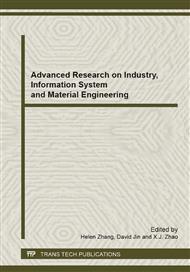p.93
p.98
p.103
p.107
p.111
p.116
p.121
p.125
p.129
Experimental Study on Turning Vibration Responses of Cutting Tool Surface Based on the Self-Power Spectral Density
Abstract:
Abstract: By means of the analysis instrument of vibration signals and acceleration sensor, the vibration responses of the upper and lower surface of the cutting tool are tested in the turning process of the numerically controlled lathe under the different spindle speed, and the time series curves and the self-power spectral density curves of the acceleration vibration signals of the cutting tool are obtained. The study indicates that : the vibration energy corresponding to the upper surface of the tool is much larger than that of the lower surface, and the vibration frequency corresponding to maximum self- power spectrum density of the tool on upper surface is about 150Hz, but the vibration frequency of the lower surface has a big fluctuation.
Info:
Periodical:
Pages:
111-115
Citation:
Online since:
March 2013
Authors:
Price:
Сopyright:
© 2013 Trans Tech Publications Ltd. All Rights Reserved
Share:
Citation:


